Know Your Enemy: Diagnosing Jay Gruden’s Offense
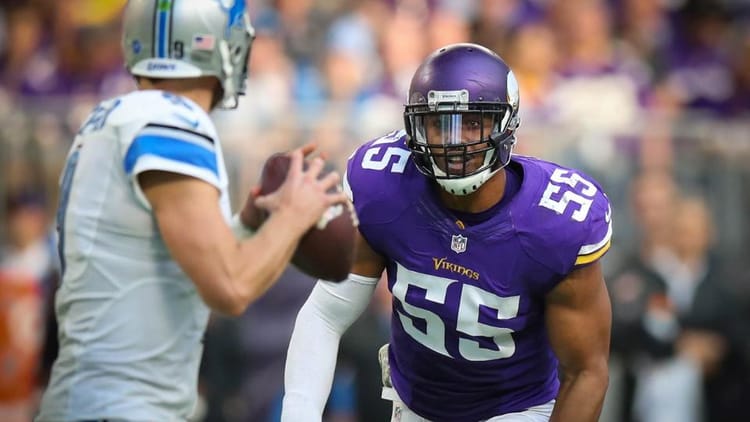
The Minnesota Vikings remain one game up in the NFC North standings, but it appears as if the sense of urgency that had been lost during the team’s three-game losing streak has returned.
“The big thing is we need to win,” Vikings coach Mike Zimmer said (Vikings.com). “I mean, it’s time, we need to win. At the end of the day, that’s the most important thing. This kind of looked like the team I’ve had for awhile this week, and hopefully we carry it over.”
Minnesota took a step in the right direction offensively against the Detroit Lions, but a culmination of late-game mistakes ultimately led to a discouraging 22-16 overtime loss.
The Vikings head out on the road this week to face the Washington Redskins at FedEx Field in Landover, Md. with the goal of putting an end to their losing streak against a foe that is familiar in more ways than one.
Staples of Jay Gruden’s Offense
There are few people in the National Football League that know Washington’s head coach as well as Mike Zimmer.
Jay Gruden, who served as the Cincinnati Bengals’ offensive coordinator from 2011-13 prior to being hired as the Redskins head coach in 2014, spent three years working as Zimmer’s counterpart in Cincinnati.
“I guess we were always trying to beat each other, but when you’re on the same team, you’re just trying to go against [each other],” Zimmer said (Redskins.com). “It was always good chess matches.”
Zimmer and the Vikings got a look at the Redskins during Gruden’s first season as head coach in Washington. Trailing 26-21 late in the game, Matt Asiata found the end zone on a one-yard rush attempt and added a two-point conversation to seal a 29-26 Minnesota victory. While quite a bit has changed since Zimmer and Gruden began their respective tenures as head coaches, many of the same principles still apply with regard to how Washington operates from an offensive perspective.
“First off, Jay’s an excellent coach,” Baltimore Ravens coach John Harbaugh told the Washington Post after the Redskins hired Gruden in 2014. “It’s a West Coast offense. I think the Grudens have their own patent on their own version of the West Coast offense because they built it so well. But it’s based on running the ball effectively. They’re very physical up front, and three-step, controlled passing.
“The ball comes out quickly and it’s really hard to get to the quarterback. It’s based on probably a quick read and the ball’s out quick.”
Vikings fans will recognize many of the concepts and the overall style employed by Gruden this weekend, as interim offensive coordinator Pat Shurmur calls plays under a similar school of thought, which was on display against the Lions.
There are three key factors that embody Gruden’s West Coast offense in Washington:
- Run the Ball Effectively
- Play Physical Up Front
- Controlled Passing Game (Three-Step Drops, Play-Action, Run-After-Catch)
Beginning with the first staple on our list, Washington has done a very nice job setting the pace of the game with its rushing attack. Despite ball control issues — looking at running back Matt Jones, who reportedly may be inactive, here — the Redskins have been able to establish an effective ground game all season long. According to ESPN, Washington currently comes in at No. 8 in team rushing yards per attempt (4.5), which is a testament to the team’s ability to run for positive yards regardless of which back carries the ball.
Jones (4.6), Chris Thompson (4.6) and Rob Kelley (5.0) have combined to carry the load for the Redskins. Each running back offers a slightly different skill set and is used differently within Gruden’s scheme, but all three rushers have had little issue setting the tone behind a physical front five that has been forced to play without suspended left tackle Trent Williams.
With Jones — who had previously been the team’s primary running back — potentially set to miss Sunday’s action, let’s take a look at how Washington has used Kelley this season. And where better to get a glimpse of an offensive line’s physicality than within the red zone:
Staring down 2nd-and-3 from the Bengals’ four-yard line, Cousins hands off to Kelley behind a front that includes tight end Jordan Reed attached to the right side. As shown in the above screen shot, the blocking opens up a lane to the left side, but with the defensive coverage flowing in that direction, Kelley elects to attack a cutback alley to the right side of the formation.
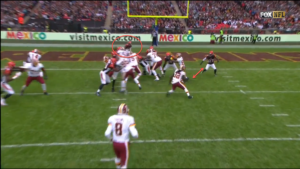
Credit: NFL Game Pass
Reed kicks his man inside and each blocker establishes leverage, which sets up a one-on-one situation between Kelley and Bengals cornerback Dre Kirkpatrick (No. 27). The play’s design flows defensive coverage to the left side of the formation (notice the location of Cincinnati’s “deep” safety), which opens up an opportunity for Kelley to choose between beating Kirkpatrick to the right pylon on the outside or cutting back inside.
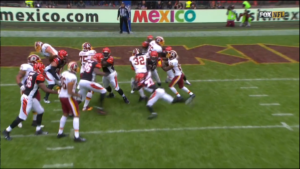
Credit: NFL Game Pass
Kelley chooses the latter, cutting back inside against Kirkpatrick’s momentum, and drags the Cincinnati defensive back through a newly-opened lane before bulldozing his way into the end zone.
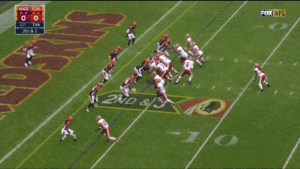
Credit: NFL Game Pass
It isn’t the prettiest four-yard touchdown one will ever see, but Kelley’s score is a perfect reflection of the tough, hard-nosed rushing attack that Gruden calls for behind a nasty offensive line in Washington.
For as gritty as the Redskins’ offensive line is at blocking for the team’s ground game, this unit without Williams is far less imposing in pass protection. This, however, is largely neutralized due to a quick-paced, controlled passing attack that features multiple technicians and the big-body tight end presence of Reed.
With DeSean Jackson out due to injury, the Vikings will not have to worry about the vertical threat’s lightning-fast downfield presence, but the Redskins still possess the ability to hit the home run with screens and quick, underneath passing plays.
Jamison Crowder, a second-year wide receiver and former fourth-round pick out of Duke, is arguably the greatest receiving threat Washington will boast on Sunday. He is a quick, change-of-pace receiver with excellent fundamental skills and dangerous after-the-catch ability.
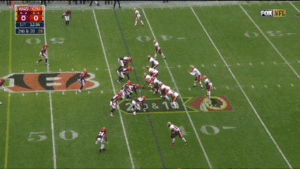
Credit: NFL Game Pass
As shown in the above GIF, Cousins dumps a short screen off to Crowder — who lined up out of the slot on the right side of the formation — with the intention of giving the shifty receiver room to go to work on the outside.
Jackson (No. 11) sets up a nice block, but the Bengals defense swarms to cut off the outside lane. With some help from second-year offense guard Brandon Scherff (No. 75), who pancakes a defender to open a narrow lane, Crowder is able to explode for a 17-yard catch-and-run on a well-executed screen play. It is these types of calls that Gruden uses to keep opposing defenses on their heels while also avoiding sacks that have a way of decimating offensive drives.
Even when facing 3rd-and-long situations, Gruden still tends to call a “controlled” passing offense. The term “controlled” should not be viewed with a negative connotation, however, as Washington maintains the personnel to make the most out of three-step drops designed around short route patterns.
Potentially the greatest threat within this construct is Reed, a hulking 6-foot-2, 246-pound tight end out of Florida. The former third-round pick is your stereotypical mismatch in the NFL, as he combines excellent size with above-average speed and short-area quickness.
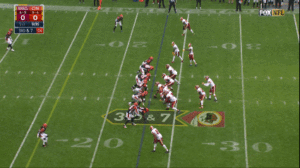
Credit: NFL Game Pass
In the above GIF, Reed runs a quick slant from the outside of the formation. Cousins recognizes a zone defense that sets Reed free across the middle and fires a pass in the tight end’s direction to allow his greatest offensive weapon to go to work — a common theme of Gruden’s offense.
Adam Jones (No. 24) sees the throw coming from a mile away and rushes up to stop the play accordingly, but Reed cuts back inside so fluidly that the Cincinnati cornerback sails right past the tight end as he crosses the first-down marker and engages in a physical battle for extra yards.
With these three weapons — Kelley, Crowder and Reed — set to be involved quite a bit in an offense that aims to chunk up yardage while taking time off the clock, Zimmer’s defense will need to be discipline in its tackling and maintain tight, man-to-man coverage while attempting to take advantage of rare opportunities in which a high-octane Vikings pass-rush can rattle Cousins.
Defending Jay Gruden’s Offense
There is a lot to like about Cousins and the Redskins offense, but there are certainly ways to slow down their attack. Some of these tactics are more obvious than others, but defending Gruden’s offense well ultimately comes down to discipline and fundamentals.
In order for the above-highlighted plays to work as well as they ultimately did, Kelley, Crowder and Reed all needed to force mistakes from their counterparts. Both Crowder and Reed forced missed tackles, which, had they been made, would have set the Redskins offense up with 3rd-and-long and 4th-down situations, respectively. While the pair of Washington play-makers certainly made it difficult on the opposition, these are mistakes that have a way of costing teams games.
Look no further than Golden Tate’s game-sealing touchdown against the Vikings during Week 9. While the score certainly represents an outstanding individual effort by the Lions wide receiver, it also required a pair of missed tackles by Xavier Rhodes and Harrison Smith to come to fruition.
Given the nature of Washington’s West Coast scheme and the high frequency of short passes, the Vikings will look to their linebacking duo of Anthony Barr and Eric Kendricks for sure-tackling and close coverage. While both players have had their share of highlight-reel moments this season, Barr and Kendricks have been largely absent during the team’s losing streak.
Kendricks, who was literally absent against Detroit, appears set to return from a concussion to help Minnesota slow down Kelley and Thompson out of the backfield. The second-year linebacker has been excellent in coverage dating back to his days at UCLA and represents a perfect answer to a pair of running backs — particularly Thompson — that have proven to be very dangerous with the ball in their hands. With Jones likely to miss Sunday’s game, Kendricks will be asked to control Thompson out of the backfield in coverage and hold Kelley to minimum yardage on rushing attempts.
Barr, on the other hand, will likely draw the game’s toughest assignment. Reed, who has caught 42 passes for 415 yards and three touchdowns this season, is too big for slot cornerback Captain Munnerlyn to cover even when completely healthy and likely too spry for veteran linebacker Chad Greenway to blanket for 60 minutes.
Even Kendricks (6-foot-0, 227 pounds), who is both physically strong and possesses excellent speed for a linebacker, is dwarfed by Reed’s imposing frame. Barr, who stands at 6-foot-4 and weighs in at 247 pounds, is able to match Reed both physically and athletically. This would appear to be a bright spot for the Vikings, as most teams fail to employ a player capable of matching Reed’s athletic gifts, but Barr has been rather disappointing this season.
Against Detroit, Eric Ebron (6-foot-4, 245 pounds) gave Barr and the Vikings all kinds of problems. While Barr wasn’t the only Minnesota defender to allow a reception to the hulking Lions tight end, he certainly did not help make the situation any better.
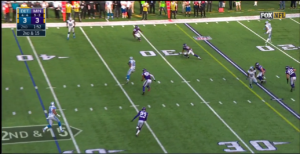
Credit: NFL Game Pass
The Lions were able to attack the field both horizontally against Minnesota’s linebackers and vertically against the team’s ailing safeties with Ebron, as he coasted to seven-catch, 92-yard effort which was largely overshadowed by Tate and quarterback Matthew Stafford.
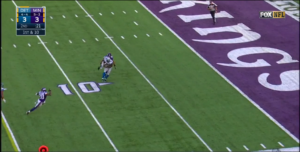
Credit: NFL Game Pass
Reed offers an eerily similar skill set to Detroit’s former first-round tight end with a longer history of success. As a result, Barr will receive somewhat of a do-over, as he will likely be in charge of stopping Washington’s big tight end more often than not.
The Wrap-Up
There is not a simple answer for slowing down a quick-paced offense that prides itself on fundamentals and consistent execution.
Leaning on multiple sacks is not going to get it done against Washington, however, as Cousins has been taken down just 11 times this season (3.3 sack percentage). These are numbers that are matched only by quarterback Derek Carr and the Oakland Raiders’ outstanding pass-protection unit.
Cousins is not immune to turnovers, however, as he has thrown seven interceptions this season, shown that he is susceptible to allowing his emotions to get the best of him in the past and has made enough untimely poor decisions in his short tenure as a starter to force Washington’s upper management to think deeply about extending the former Michigan State quarterback long-term.
Stopping the Redskins offense will ultimately come down to matching fundamentals with fundamentals, discipline tackling and, when given the opportunity, making Gruden’s decision to call a longer developing play hurt with a drive-killing sack of Cousins.
The Vikings roster maintains the defensive personnel to get the job done and a head coach with plenty of experience working against the Redskins’ offensive play-caller, but this matchup still will ultimately be decided by whichever team executes efficiently and fundamentally on a more consistent basis.

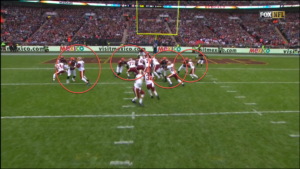
You must be logged in to post a comment.